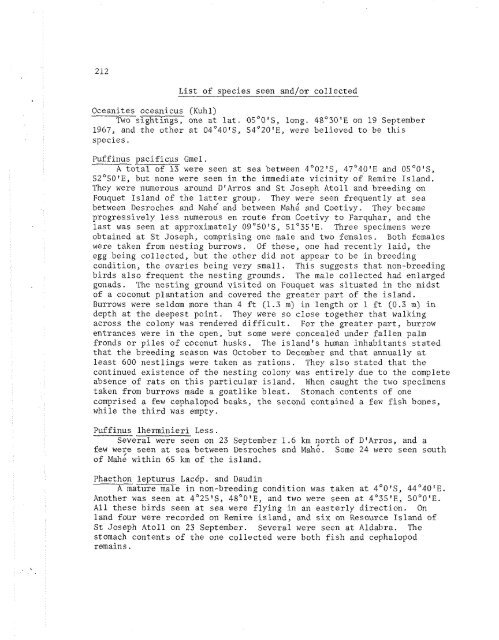ATOLL RESEARCH BULLETIN - Smithsonian Institution
ATOLL RESEARCH BULLETIN - Smithsonian Institution
ATOLL RESEARCH BULLETIN - Smithsonian Institution
Create successful ePaper yourself
Turn your PDF publications into a flip-book with our unique Google optimized e-Paper software.
List of species seen and/or collected<br />
Oceanites oceanicus (Kuhl)<br />
Two sightings, one at lat. OSOO'S, long. 4S030'E on 19 September<br />
1967, and the other at 04'40'S, 54'20tE, were believed to be this<br />
species.<br />
Puffinus pacificus Gmel .<br />
A total of 13 were seen at sea between 4'02'5, 47'40'E and OSOO'S,<br />
52"50tE, but none were seen in the immediate vicinity of Remire Island.<br />
They were numerous around D'Arros and St Joseph Atoll and breeding on<br />
Fouquet Island of the latter group. They were seen frequently at sea<br />
between Desroches and Mahg and between ~ah6 and Coetivy. They became<br />
progressively less numerous en route from Coetivy to Farquhar, and the<br />
last was seen at approximately 09"501S, 51°35'E. Three specimens were<br />
obtained at St Joseph, comprising one male and two females. Both females<br />
were taken from nesting burrows. Of these, one had recently laid, the<br />
egg being collected, but the other did not appear to be in breeding<br />
condition, the ovaries being very small. This suggests that non-breeding<br />
birds also frequent the nesting grounds. The male collected had enlarged<br />
gonads. The nesting ground visited on Fouquet was situated in the midst<br />
of a coconut plantation and covered the greater part of the island.<br />
Burrows were seldom more than 4 ft (1.3 m) in length or 1 ft (0.3 m) in<br />
depth at the deepest point. They were so close together that walking<br />
across the colony was rendered difficult. For the greater part, burrow<br />
entrances were in the open, but some were concealed under fallen palm<br />
fronds or piles of coconut husks. The island's human inhabitants stated<br />
that the breeding season was October to December and that annually at<br />
least 600 nestlings were taken as rations. They also stated that the<br />
continued existence of the nesting colony was entirely due to the complete<br />
absence of rats on this particular island. When caught the two specimens<br />
taken from burrows made a goatlike bleat. Stomach contents of one<br />
comprised a few cephalopod beaks, the second contained a few fish bones,<br />
while the third was empty.<br />
Puffinus lherminieri Less.<br />
Several were seen on 23 Seotember 1.6 km north of D'Arros. and a<br />
few we;e seen at sea between ~esroches and Mah;. Some 24 were.seen south<br />
of Mahe within 65 km of the island.<br />
Phaethon lepturus LacBp . and Daudin<br />
A mature male in non-breedinn - condition was taken at 4"O'S. 44'40'E.<br />
Another was seen at 4'25'5, 4S00'E, and two were seen at 4'3S1E, 50°0'E.<br />
All these birds seen at sea were flying in an easterly direction. On<br />
land four were recorded on Remire island, and six on Resource Island of<br />
St Joseph Atoll on 23 September. Several were seen at Aldabra. The<br />
stomach contents of the one collected were both fish and cephalopod<br />
remains.

















